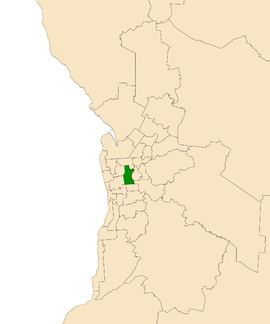State South Australia Demographic Metropolitan Area 23.4 km² Elector 24,779 | Created 1902 Electors 24,779 (2014) Founded 1902 | |
 | ||
Party Liberal Party of Australia (South Australian Division) | ||
Adelaide is an electorate for the South Australian House of Assembly. The 23.4 km² state seat of Adelaide currently consists of the Adelaide city centre including North Adelaide and suburbs to the inner north and inner north east: Walkerville, Gilberton, Medindie, Medindie Gardens, Thorngate, Fitzroy, Ovingham, most of Prospect up to Regency Road, and parts of Collinswood and Nailsworth. The boundaries have been the same for the past three elections. The federal division of Adelaide covers the state seat of Adelaide and additional suburbs in each direction.
The electorate's name comes from the city which it encompasses, which is named after Princess Adelaide of Saxe-Meiningen, the German born Queen consort of the King of England, King William IV. Originally the seat of City of Adelaide from 1857 to 1862, Adelaide was created from the seats of East Adelaide and West Adelaide as a four-seat multi-member district, surrounded by the other two metropolitan districts of 13 seats total being Torrens and Port Adelaide, from the 1902 election. Adelaide became a three-member district from the 1915 election, and then changed from a multi-member to single-member seat upon the introduction of the Playmander from the 1938 election.
For most of the next half-century, the seat was comfortably safe for the Australian Labor Party. A significant redistribution in 1983 saw the Labor two-party vote reduced from 66 percent to 47 percent, transforming into a notional marginal Liberal seat in one stroke. However, Labor retained the seat at the 1985 election, albeit as the most marginal seat in parliament. Liberal Michael Armitage narrowly took the seat at the 1989 election--the first time that they or their predecessors, the Liberal and Country League, had won it in its single-member incarnation. The Liberal high-tide in Adelaide occurred at the landslide 1993 election, with the Liberal two-party vote swelling to a safe 64.1 percent. However, it once again became a marginal Liberal seat at the 1997 election.
After a redistribution ahead of the 2002 election made the seat even more marginal, Armitage tried to transfer to the much friendlier seat of Bragg, but lost a preselection battle to Vickie Chapman. Labor candidate Jane Lomax-Smith regained the seat for Labor at the 2002 election as a marginal seat, one of two gains that assisted Labor in forming government. It became a safe Labor seat at the landslide 2006 election on a 60.2 percent two-party vote, before the Liberals won Adelaide for the second time at the 2010 election on a swing of over 14 percent, turning it from safe Labor to marginal Liberal in one stroke. The Liberals retained Adelaide at the 2014 election on a marginal 52.4 (−1.8) percent two-party vote.
Upon the release of the 2016 draft electoral redistribution, Liberal MP Rachel Sanderson organised the mass distribution of a pro forma document in the two inner metropolitan suburbs of Walkerville and Gilberton, which aimed for residents to use the pro forma document to submit their objection to the commission in support of Sanderson's campaign to keep the two suburbs in her seat of Adelaide, which in the draft would have been transferred to neighbouring Torrens. Sanderson's position however was at odds with her own party's submission which in fact agreed with the commission that Walkerville should be transferred to Torrens. Under the commission's draft proposal, the Liberal margin in Adelaide would have been reduced from 2.4 percent to 0.6 percent, but would have also resulted in the Labor margin in Torrens reduced from 3.5 percent to 1.1 percent. Of a record 130 total submissions received in response to the draft redistribution, about 100 (over three quarters of all submissions) were from Walkerville and Gilberton. As a result, the commission reversed the draft decision in the final publication.
